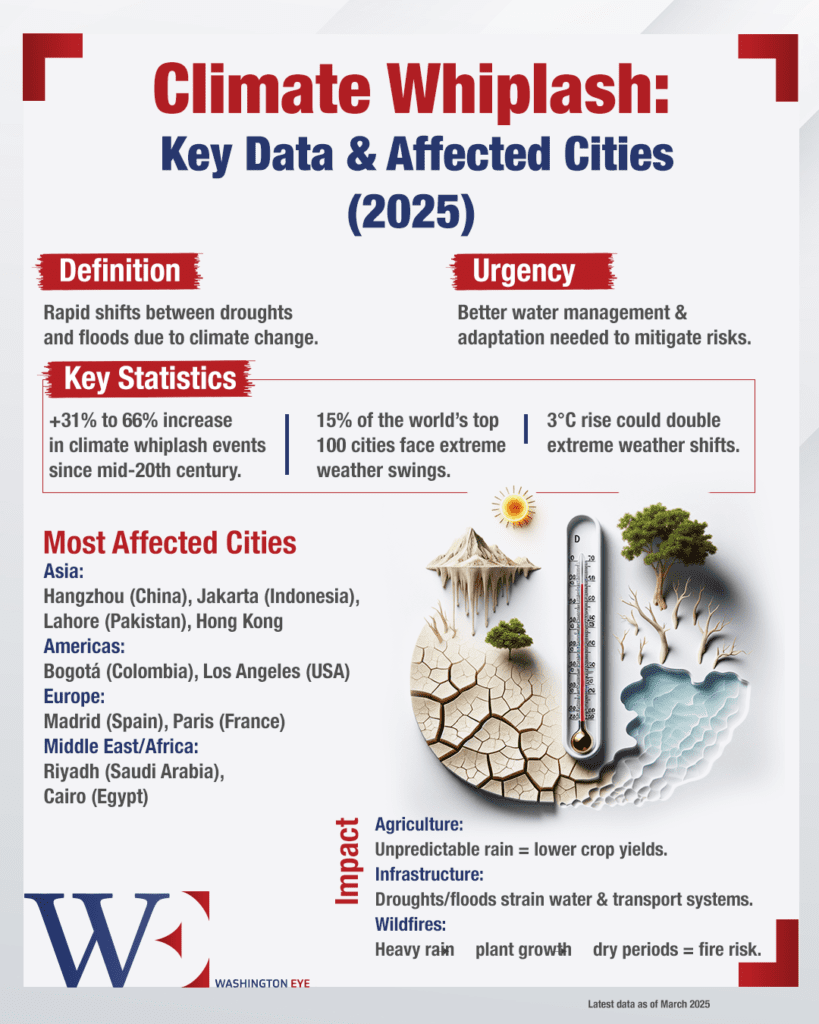A new study has highlighted the increasing phenomenon of “climate whiplash,” where major cities across the world are experiencing abrupt and extreme shifts between drought and heavy rainfall. This erratic climate pattern, driven by global warming, is placing urban areas under unprecedented stress. The study, which examined 112 of the world’s most populous cities, underscores how rapidly changing climate conditions are reshaping the environment and making cities more vulnerable to extreme weather events. From prolonged droughts to devastating floods, the impacts of climate whiplash are growing more severe, raising urgent concerns about urban resilience and preparedness.
The Growing Prevalence of Climate Whiplash
The study found that a staggering 95% of the cities analyzed showed a significant trend toward either prolonged wet or dry conditions, indicating that nearly all major urban centers are experiencing some degree of climate instability. Particularly concerning is the increasing frequency of extreme swings between these two states. For instance, cities such as Hangzhou in China, Jakarta in Indonesia, and Dallas in the United States have all faced repeated cycles of intense drought followed by heavy downpours. These sudden shifts pose significant challenges for urban planning, disaster response, and resource management.
For urban areas, the unpredictability of climate whiplash makes it increasingly difficult to prepare for weather-related disasters. Prolonged dry spells deplete water supplies, harming agriculture and putting pressure on urban water systems. When these dry periods are suddenly interrupted by heavy rainfall, the parched ground struggles to absorb the water, leading to flash floods, landslides, and overwhelmed drainage systems. The repeated nature of these cycles makes recovery efforts more difficult, as cities are forced to continuously shift their focus between managing drought conditions and responding to flooding emergencies.
Regional Trends: The Wet Gets Wetter, The Dry Gets Drier
The study also highlighted strong regional trends in how climate whiplash is affecting different parts of the world. In Europe, the Arabian Peninsula, and the southwestern United States, many cities are becoming drier over time. Madrid, for example, has seen a marked shift toward arid conditions, while Riyadh has experienced a sharp decline in annual precipitation levels. These trends are particularly alarming in regions that are already prone to water shortages, as extended dry periods place even greater pressure on existing resources.
On the other hand, cities in South and Southeast Asia, as well as parts of West Africa, are facing the opposite problem—an increase in extreme rainfall. Indian cities like Lucknow and Surat, as well as Kano in Nigeria, have seen significantly wetter conditions in recent decades. While increased rainfall might seem like a benefit in some cases, these changes are often accompanied by devastating floods, displacement of communities, and waterborne disease outbreaks.
The Challenges for Urban Areas
One of the most pressing concerns for cities experiencing climate whiplash is the strain it places on infrastructure. Most urban water and drainage systems were not designed to handle such extreme fluctuations between dry and wet conditions. During extended dry periods, groundwater depletion and water shortages become major concerns, particularly for cities that rely on reservoirs and rivers for their water supply. When these cities then experience heavy rainfall, their systems may be unprepared for the sudden influx of water, leading to catastrophic flooding.
Another significant challenge is the increased social vulnerability that comes with climate instability. Cities with poor infrastructure and weak governance structures, such as Karachi in Pakistan and Khartoum in Sudan, are particularly at risk. The rapid alternation between droughts and floods exacerbates existing problems like food insecurity, displacement, and economic instability. In developing countries, these effects are felt most acutely by lower-income populations, who often live in areas that are more prone to flooding or have limited access to reliable water supplies.



















